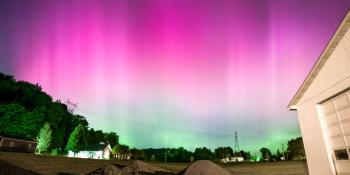Prohlížíte si archiv úterý 6. listopadu 2001
Report sluneční aktivity
Any mentioned solar flare in this report has a scaling factor applied by the Space Weather Prediction Center (SWPC). Because of the SWPC scaling factor, solar flares are reported as 42% smaller than for the science quality data. The scaling factor has been removed from our archived solar flare data to reflect the true physical units.
Zpráva o sluneční-geofyzikální činnosti 2001 Nov 06 2200 UTCPřipraveno NOAA © SWPC a zpracováno SpaceWeatherLive.com
Společná zpráva USAF / NOAA o sluneční a geofyzikální činnosti
SDF číslo 310 Vydáno za 2200Z za 06 Nov 2001IA. Analýza solárních aktivních oblastí a aktivity od 05-2100Z do 06-2100Z Solar activity was at moderate levels. Four M-class
events were reported during the period. Region 9687 (S20E08)
produced the largest event, an M2/1b flare at 06/0300 UTC. This
event also had an accompanying Type II radio sweep (velocity
estimated at 600 km/s). Region 9687 developed into a complex
beta-gamma-delta magnetic classification during the period. Region
9690 was by far, the most active region on the disk today. It
produced several C-class events and two minor M-class events. Region
9690 has fully rotated onto the disk and appears to be a moderately
large region (750 millionths) with a beta-gamma magnetic
classification. Region 9684 (N06W55), which produced the X1/3b
proton flare on 04 November, retains a beta-gamma-delta magnetic
classification, but did not produce any significant activity during
the period.
IB. Předpověď sluneční aktivity
Solar activity is expected to continue
to be moderate to high. Regions 9684, 9687, and 9690 all possess
major flare potential.
IIA. Souhrn geofyzikální aktivity 05-2100Z až 06-2100Z
The geomagnetic field was at unsettled to severe storm conditions.
The full-halo coronal mass ejection (CME) from the 04 November event
impacted the geomagnetic field at 06/0150 UTC. This was indicated by
a 90 nT sudden impulse as measured by the USGS Boulder magnetometer.
Severe geomagnetic storming occurred between 06/0000 and 06/0600 UTC
and 15-1800 UTC. The greater than 10 MeV proton event peaked at
31,700 pfu at 06/0215 UTC. The greater than 100 MeV proton event
peaked at 253 pfu at 06/0220 UTC. Both proton events levels declined
sharply during the period but continued through the end of the day.
A polar cap absorption event remained in effect.
IIB. Předpověď geofyzikální aktivity
The geomagnetic field is
expected to be unsettled to minor storm conditions on the first day
of the period and then declining to mostly quiet to unsettled, with
isolated active conditions possible, on days two and three. However,
there have been several long and near long duration flares in the
last two days that could have produced earth-directed coronal mass
ejections. Since the onset of the proton storm at approximately 1700
UTC on 04 November, the LASCO instrument has been saturated by the
particles and it is nearly impossible to determine if any CME's have
been produced or if they are earth-directed. Impacts from any
earth-directed CME's would obviously cause an increase in
geomagnetic activity. The greater than 100 MeV proton event is
expected to continue until approximately 07/1200 UTC. The greater
than 10 MeV proton event ended the day at 567 pfu and is expected to
continue for at least another 24 hours. The Polar cap absorption
event is expected to last until 09/0000 UTC.
III. Pravděpodobnosti události 07 Nov až 09 $ 4
| Třída M | 80% | 80% | 80% |
| Třída X | 25% | 25% | 25% |
| Proton | 99% | 99% | 80% |
| PCAF | in progress | ||
IV. Proud Penticton 10.7 cm
Pozorováno 06 Nov 237 Předpovězeno 07 Nov-09 Nov 235/235/230 90 denní průměr 06 Nov 208
V. Geomagnetické indexy A
Pozorováno Afr/Ap 05 Nov 012/013 Odhadovaný Afr/Ap 06 Nov 075/100 Předpovězeno Afr/Ap 07 Nov-09 Nov 030/030-012/015-010/012
VI. Pravděpodobnosti geomagnetické aktivity 07 Nov až 09 Nov
| A. Střední zeměpisné šířky | |||
|---|---|---|---|
| Aktivní | 50% | 35% | 35% |
| Menší bouře | 25% | 15% | 15% |
| Silná bouře | 04% | 04% | 04% |
| B. Vysoké zeměpisné šířky | |||
|---|---|---|---|
| Aktivní | 40% | 30% | 25% |
| Menší bouře | 35% | 15% | 15% |
| Silná bouře | 20% | 10% | 05% |
Všechny časy v UTC
<< Přejít na stránku s denním přehledem
Poslední zprávy
Nejnovější zprávy na fóru
AR3664 1091Incoming Active Regions 374Another interesting video 3AR3685 77Latest SC25 Predictions 128
Další témataPodpora SpaceWeatherLive.com!
Mnoho lidí přichází do SpaceWeatherLive, aby sledovali aktivitu Slunce nebo pokud je vidět polární záři, ale s větším provozem přicházejí i vyšší náklady na server. Zvažte dar, pokud vás baví SpaceWeatherLive, abychom mohli udržovat web online!

Fakta o počasí ve vesmíru
| Poslední X-záblesk | 15. 05. 2024 | X2.9 |
| Poslední M-záblesk | 19. 05. 2024 | M1.6 |
| Poslední geomagnetická bouře | 17. 05. 2024 | Kp6 (G2) |
| Dny bez skvrn | |
|---|---|
| Poslední den bez skvrn | 08. 06. 2022 |
| Průměrný měsíční počet slunečních skvrn | |
|---|---|
| dubna 2024 | 136.5 +31.6 |
| května 2024 | 157.5 +21 |
| Last 30 days | 168.7 +50.9 |


